Density Functional Theory; A New Route for Structural and Thermodynamic Parameters Calculations
DOI:
https://doi.org/10.24297/jap.v14i1.7285Keywords:
Density functional theory (DFT), Free energy, Thermodynamic parameters, Entropy, Specific heatAbstract
Structural and thermodynamic parameters of the studied virgin polymeric matrices poly e-caprolactone (PCL), Chitosan (Chi) and their polymer blend were investigated using theoretical density functional theory (DFT). Thermodynamic functions were calculated based on vibrational frequencies and optimized geometrical coordinates in the temperature range 25-1000 °K which cannot be amended easily. Calculated free energy was found to be convex in terms of extensive variable and concave in terms of intensive ones.
Downloads
References
- Tambara M, Striccoli M., Comparalli R, Curri MI, Patralla A, ad Agodtiano A, Optical Properties of Hybird Composites, based on highly luminescent CDS Nanocrystals in Polymer, Nanotechnology 2004;15(4):S240.
- Hussain F, Hajjati M, Okamato M, Gorga RE, Polymer Matrix: Nanocomposites, Processing Manufacturing and Applications: an Overview, J. of Composite Materials 2006;40(17)1511.
- Khor E, Lim LY, Implantable applications of chitin and chitosan, Biomaterials 2003;24(13):2339.
- Pawlak A, Mucha M, Thermogravimetric and FTIR studies of chitosan blends, Thermochimica Acta 2003;396(1-2):153.
- Shahidi F, Arachchi JKV, Jeon YJ, Food applications of chitin and chitosans, Trends in Food Science & Technology 1999;10(2):37.
- Davies RC, Neuberge A, Wilson BM, Dependence of Lysozyme Activity on PH and Ionic Strength, Biochimica Et Biophysica Acta 1969;178(2):294.
- Pangburn S H, Trescony PV, Heller J, Lysozyme Degradation of Partially Deacetylated Chitin, Its Films and Hydrogels, Biomaterials 1982;3(2):105.
- Shigemasa Y, Saito K, Sashiwa H, Saimoto H, Enzymatic Degradation of Chitins and Partially Deacetylated Chitins, International Journal of Biological Macromolecules, 1994;16(1):43.
- Wiseman DM, Domb AJ, Kost J, Handbook of Biodegradable Polymers, Taylor & Francis, 1998.
- Santin M, Huang S, Iannace S, Ambrosio L, Nicolais L, Peluso G, Synthesis and characterization of a new interpenetrated poly(2- hydroxyethylmethacrylate)-gelatin composite polymer, Biomaterials 1996; 17(15):1459.
- Olabarrieta I, Forsstrom D, Gedde UW, Hedenqvist MS, Transport properties of chitosan and whey blended with poly(epsilon-caprolactone) assessed by standard permeability measurements and microcalorimetry, Polymer 2001;42(9):4401.
- Vijayalekshmi V, Khastgir D, Chitosan/partially sulfonated poly (vinylidene fluoride) blends as polymer electrolyte membranes for direct methanol fuel cell applications, Cellulose 2018;25(1):661.
- Demetgül C, Beyazit N, Synthesis, characterization and antioxidant activity of chitosan-chromone derivatives, Carbohydrate polymers 2018;181:812.
- Correlo VM, Boesel LF, Bhattachary M, Mano JF, Neves NM, Reis RL, Properties of melt processed chitosan and aliphatic polyester blends, Materials Science and Engineering: A 2005; 403(1–2)57.
- SarasamA, Madihally SV, Characterization of chitosan–polycaprolactone blends for tissue engineering applications, Biomaterials 2005; 26(27):5500.
Downloads
Published
How to Cite
Issue
Section
License
 All articles published in Journal of Advances in Linguistics are licensed under a Creative Commons Attribution 4.0 International License.
All articles published in Journal of Advances in Linguistics are licensed under a Creative Commons Attribution 4.0 International License.




